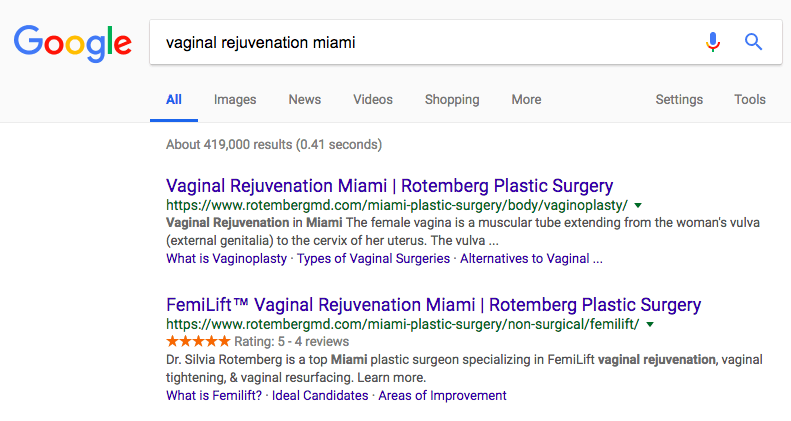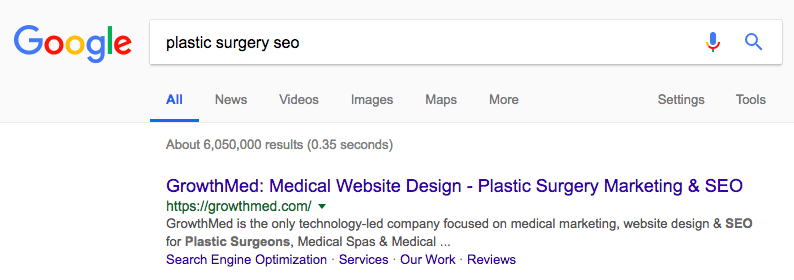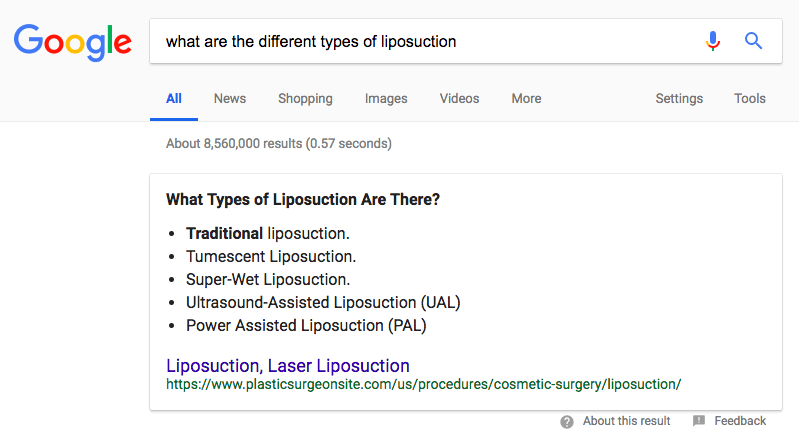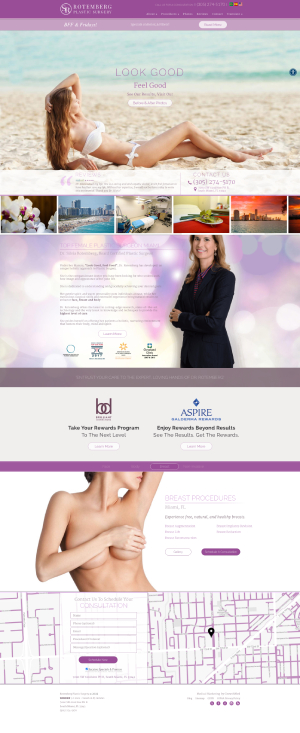Medical Content Writing For Healthcare Practices
Conveniently located to serve the areas of Undefined

Content has been and continues to be king and website content writing for SEO is as essential as ever. With medical, plastic surgery, and aesthetic practices, strong page content is a critical component of making your website visible to the public.
In our experience, and through non-stop tinkering, we’ve uncovered many of the most proven strategies for strong page content, which we explain in greater detail below.
Contents
Google Panda Algorithm Update
February 2011 was the initial release date of the Google Panda algorithm update. The change aimed to lower the rank of “low-quality sites” or “thin sites,” particularly “content farms,” and return higher-quality sites near the top of the search results. Google continued to release updates to the Google Panda algorithm about once a month for the next few years, culminating in rolling the Panda algorithm into their main algorithm in July 2015.
If the majority of your website has duplicate or thin content, Google is more likely to penalize your entire site, even removing your site from its index altogether. Previously, Google used to roll out monthly updates, so after fixing the problem, there was a lag time before you could see traffic flow improve. Google’s updates are continuous, so the algorithm catches your website corrections much more quickly.
The Panda algorithm is notable because businesses that relied on black hat tactics (cheating) and/or enjoyed good positions in Google despite not having the good content took catastrophic hits to their business, resulting in a massive freakout. Companies that were once generating tens of millions of dollars or more per month went bankrupt.
The most common black hat strategy was to generate as many web pages as possible in an attempt to fill up Google’s index to maximize matches to queries. The black hat tactics included auto-generating pages, creating very thin content (i.e., a 120-word paragraph), and duplicating pages from other people’s websites.
Other tactics included copying and pasting one sentence from one website and another sentence from another website, but changing stop words (a, an, and, the, etc) to fool their algorithm into thinking the content was unique. Black-hat strategists even created filters for categories, tags, and date archives on blogs to re-display the same content with different URLs. For the most part, these tactics no longer work. Steer clear of these strategies. Most websites that have these issues and take the time to correct them, quickly see their pages start to rise in Google rank — sometimes overnight!
Duplicate & Thin Content Writing Penalty
Duplicate content comes in two forms: external duplicate content or internal duplicate content. External duplicate content is copied from an external source, like another website. A Breast Augmentation procedure page copied from another website and placed on your website considered to be duplicate content. Internal duplicate content refers to identical content appearing on more than one page of your website. An example is blog posts that are copied and placed under different parent pages to generate a new URL, providing absolutely no new content or value, that Google also has to crawl through.
Thin content is exactly what it sounds like. A page with only one image or a Breast Augmentation procedure page with only a single paragraph provides little value for the potential patient. Some websites break up the Breast Augmentation procedure content into one or two paragraphed parts that are placed onto separate pages. The thinness of the content results in low-quality pages. On the other hand, if all those pages were merged into one, the resulting content could have been an impressive, 1,500+ word in-depth page that Google would consider relevant to the topic.
In-Depth Unique SEO Content
Google wants in-depth, unique content focused on one topic that remains relevant for months or even years. They will reward you handsomely if you supply it. To get an idea of in-depth, unique content, think about a Wikipedia page, which provides a comprehensive description about a single topic. The page is broken up into sections similar to this chapter.
People writing a Wikipedia page are not trying to think about keyword density, how many times to write a keyword on the page, or what relative keywords they should use.
If you write a 1,500+ word procedure page all about the Vaginal Rejuvenation procedure and structure it properly, you will cover all the things that black hat SEO tries to shortcut its way into without the risk of hurting your rankings. A legitimate, high-quality article also provides those keywords – it just takes work.

Structuring A Page
There are many elements to a page, but the central aim in page structure should be to send every signal possible to Google indicating what the page is about. Your URL, title of the page, and main heading tag (called an “H1”) should all reference the same thing. The topic of a page about Rhinoplasty should be 100% clear, with zero ambiguity. The URL should say “rhinoplasty,” the title of the page should say “rhinoplasty,” the main heading H1 should say “rhinoplasty,” and all of the content, including images, should be about rhinoplasty.
URLs
The URL, which stands for Uniform Resource Locator, is usually located at the top of your web browser where you can type the address to your website or specific web page (e.g., https://growthmed.com/). You want to utilize a hierarchical URL structure over a flat URL structure. The path segment of hierarchical URL structure is organized by subcategories whereas a flat URL structure is no more than one level deep.
With a hierarchical structure, content about “surgical procedures”could have “body” and “face” subcategories or subdirectories, providing search engines and people with a semantic understanding of how your site’s content is structured as you can see here:
https://growthmed.com/surgical/face/rhinoplasty/
Now take a look at the following example of the same content structured with a flat URL:
https://growthmed.com/rhinoplasty/
Hierarchical URL structures make it clear that a page is about a specific surgical procedure; about a specific body part. Some people had used flat URL architectures with the false assumption that the path segment was closer to the domain, resulting in a higher Google ranking. They branched all pages directly off the root of the domain. However, if everything is important, nothing is important. Just as content should be structured for optimal search engine understanding, your URL architecture should be structured for Google’s understanding.
Meta Titles
The meta title refers to the title of a web page, which is not necessarily visible in the content. A web page’s meta title is displayed for the Google search result. A tabbed browser shows the title of the page. The abundant online advice about how to structure your title tag of the page is mostly obsolete strategies that no longer work or are just bad ideas.
Tip: For a page that has a long title, hover your mouse over the tab to see the entire title.

Title tags should be simple and short; the primary keyword should appear at the beginning of the meta title. Beyond about 50-60 characters long, title tags will get truncated when displayed on Google’s result page. Google will rewrite bad titles for you so, please, do not go crazy with keywords in titles. Make sure every page has a title tag with a unique title. The name of the procedure you are targeting should be mentioned first, followed by the city you are targeting, and finally the name of your practice for branding purposes.
For example, if you are going after VASER in Denver, CO, your title should simply be: “VASER in Denver, CO | GrowthMed Plastic Surgery”.
After your result for VASER is on the first page on Google, which lists the top 10 results, add descriptive words to the title that may help the CTR (Click Through Rate) for your result. For example, you could make it “VASER in Denver, CO – Cost – Reviews | GrowthMed Plastic Surgery”, or “VASER in Denver, CO (Insiders Guide) | GrowthMed Plastic Surgery”, etc.

Meta Descriptions
The meta description is the description people see on Google’s result page after they type in a query. They can read what the page is about and decide if they want to click on it. A raw meta description tag looks like this in HTML:
<meta name=”description” content=”Natural Plastic Surgery group specializes in cosmetic surgery of the face, breast, and body.”/>
Meta descriptions are not totally critical for search engine rank, however they have a huge impact on user click-through from search to your content. The description is your chance to let the visitor know exactly what they will find on a page. Think of the meta description as an advertisement for the page. Include your keywords in the page description, since Google will bold them when people search for them. Limit the length to 135-160 characters, and don’t put your keywords at the end, since Google will truncate the last characters exceeding the limit. Do not duplicate your meta descriptions. Finally, add a call to action at the end. For example, you can end with “click here to read more.”

Headings
A good article is broken down into sections, or a table of contents, similar to a Wikipedia page (or this chapter). Structure your text with headings and sub-headings by using the proper HTML markup. HTML (“Hyper Text Markup Language”) is what the Google spiders/robots read when they are crawling your page. For these spiders/robots to understand what the page is about and how each section of your content relates to the rest of the page, simply use HTML heading tags. The most important one for a page is the <H1> tag because it signifies what the page is about.
If the main topic of the page is Mommy Makeover, “Mommy Makeover” should be the only <H1> tag on the page. The next section might be “Types of Procedures Included,” which should be an <H2> tag. Under that section, you might have subsections like Breast Augmentation, Tummy Tuck, and Liposuction that would be wrapped in <H3> tags. Notice how the structure is topically similar to a table of contents. With this structure, a robot can follow and understand your content and how it is structured.
Body Content
This is how you make the page pretty and easy to read. First rule: Eliminate big blobs of content.
Avoid large blocks of text. Keep your writing simple.
Remember, we want to make the site a valuable asset and a good user experience for the potential patient. To determine whether or not your site is a good user experience, Google assesses elements like images, videos, bolded words, bulleted lists, and tables. These elements keep the web visitor on your page instead of bouncing back to Google and also shows Google what the page is about so that relevant Google searches become likely to land on your page.
Google can detect when content is emphasized through bolding, bulleted lists, tables of information, boxes around important content. Google can potentially use this emphasized content in what are called Featured Snippets, in which a user enters a question at the top of the page, and Google pulls data from your webpage to answer the question. This will become more important as more people use voice search.

How to Understand Schema Markup
Schema was created initially in 2011 by a collaboration between Google, Microsoft, Yahoo, and Yandex. The markup tells search engines exactly what the data on your web page means in a structured way.
Schema can be used to define hundreds of elements to help a search engine understand the information displayed on a web page. It is an open source initiative, and the vocabulary continues to expand.
Schema.org provides an example: <h1>Titanic</h1> will display “Titanic” as a top level heading. But that HTML tag has no information about what that title means. “Titanic” might be referring to the boat or it could be a reference to the movie. This confusion can prevent Google from considering your content relevant to its topic. For example, a web page about the movie Titanic might have HTML markup looking like this:
<div>
<h1>Titanic</h1>
<span>Director: James Cameron</span>
<span>Historical Fantasy</span>
<a href="https://growthmed.com/Titanic-trailer/">Trailer</a>
</div>
Adding Schema markup we get the following:
<div itemscope itemtype ="http://schema.org/Movie">
<h1 itemprop="name">Titanic</h1>
<span>Director: <span itemprop="director">James Cameron</span> </span>
<span itemprop="genre">Historical Fantasy</span>
<a href="https://growthmed.com/Titanic-trailer/" itemprop="trailer">Trailer</a>
</div>
Search engines can now understand not just that https://growthmed.com/Titanic-trailer/ is a URL, but specifically that it’s the URL for the movie trailer.
Search Engine Result Page (SERP) Optimization
Adding Schema markup to your HTML improves the way your page displays in search engine result pages (SERPs) by enhancing the rich snippets that are displayed beneath the page title. For example, you could have a testimonial written on your web page, but to Google, that is just a bunch of words.
Implementing Schema enables Google to identify the review, the author of the review, the date it was published, and its star rating. Google can now interpret the total number of reviews on your web page, and their average score; information it can display when your web page shows up on Google’s search result page.

Under the title in the Figure amp-review-stars, the green URL has an arrow and “Medical Marketing Services” in plain English instead of the remainder of the URL, which would include forward slashes like the following:
https://growthmed.com/medical-marketing/website-design/
Google can display the URL like this because Schema explains how the website is structured.
You can use Schema to tell Google you are a plastic surgeon and to identify your office’s physical address, your specialty procedures, your procedure price ranges, your phone number, your social network profiles, your company logo, your patient testimonials, and so on.
Schema enables you to sculpt your organic Google search result to look similar to the paid advertising displayed at the top of the page. Once Schema takes a listing to prominence in search engine result pages, visibility usually greatly improves the click-through rates to your website. Combine this with tactics for lowering your bounce rates and you have an amazing combination to rocket to the top of Google’s rankings.
Less than one-third of Google’s search results include a rich snippet with Schema.org markup. Schema markup is a huge area of opportunity; a Schema markup implementation can move the dial as quickly as other good SEO tactics.
Is Your Practice’s Site Powered By Quality Content Writing?
The value of content is undeniable, but the best strategies and practices for creating high-quality content are constantly evolving and becoming more sophisticated. Digital Marketing Agencies with a strong foundation in technology will naturally have an advantage in keeping up with the fast-paced evolution of Google’s Search algorithm. This is both an instinctive part of being technologists, but also a vital part of success in a highly competitive digital space.




















































